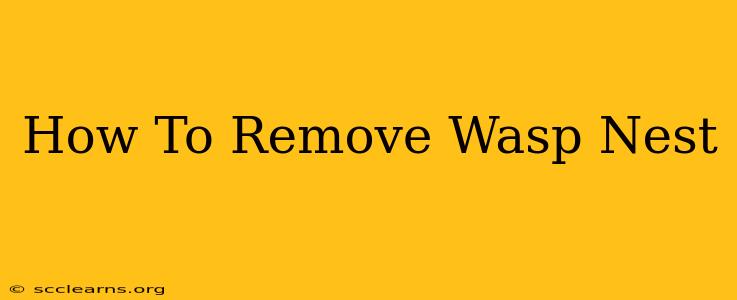Wasps. Those buzzing, stinging insects that can turn a peaceful afternoon into a frantic scramble. While wasps play a vital role in the ecosystem, a nest too close to your home or frequented areas presents a clear danger. Removing a wasp nest isn't a task to take lightly, but with the right knowledge and precautions, you can successfully eliminate the threat without putting yourself at risk. This guide will walk you through the process, step-by-step.
Assessing the Situation: Identifying the Type of Wasp and Nest Location
Before you even think about removing a wasp nest, identification is key. Different wasp species have different behaviors and nest structures, influencing your removal strategy. Common types include:
- Yellow Jackets: These are highly aggressive and will defend their nest fiercely. Their nests are typically found underground or in wall cavities.
- Paper Wasps: These are less aggressive than yellow jackets, but still capable of stinging. Their nests are often exposed, resembling upside-down umbrellas hanging from eaves or branches.
- Bald-faced Hornets: These are large, black and white wasps with highly aggressive behavior. Their nests are large, enclosed paper nests often found in trees or shrubs.
Nest location is equally crucial. A nest high up in a tree requires different tactics than one nestled in your garden shed. Consider factors like:
- Accessibility: Can you easily reach the nest without climbing ladders or using special equipment?
- Proximity to people and pets: Is the nest in a high-traffic area?
- Surrounding environment: Are there any obstacles that could hinder removal (power lines, fragile structures)?
Preparing for Wasp Nest Removal: Safety First!
Removing a wasp nest is inherently risky. Your safety is paramount. Never attempt removal without proper preparation:
Essential Protective Gear:
- Protective Suit: A full-body beekeeping suit offers the best protection, covering your entire body and face.
- Gloves: Thick leather or nitrile gloves are essential to protect your hands from stings.
- Eye Protection: Wear goggles or a face shield to prevent stings to your eyes.
- Footwear: Wear sturdy shoes or boots to protect your feet from accidental stings.
Choosing the Right Time:
Nighttime is best. Wasps are less active at night, making removal safer and more effective. However, ensure you have adequate lighting.
Tools for the Job:
The best method for wasp nest removal depends on the nest's size, location, and type. You might need:
- Wasp spray: Choose a commercial wasp and hornet spray specifically designed for nest elimination. Follow the instructions on the product label carefully.
- Vacuum cleaner: A powerful vacuum with a long hose can be used to suck up the nest and its occupants, particularly for smaller nests.
- Long-handled tools: For nests that are hard to reach, you might need a long-handled scraper or brush to knock down the nest. Caution: Only use this method if the nest is high up and you have ample safety gear.
Removing the Wasp Nest: Step-by-Step Guide
1. Apply the Insecticide: Following the manufacturer's instructions, carefully apply the wasp spray to the nest's entrance and surrounding areas. Maintain a safe distance to avoid stings.
2. Wait and Observe: After applying the spray, wait for the recommended time (usually 15-30 minutes) for the insecticide to take effect. Do not approach the nest during this time.
3. Carefully Remove the Nest: Once the wasps are incapacitated, use a long-handled tool to carefully remove the nest from its location. Bag the nest immediately in a heavy-duty garbage bag and seal it tightly.
4. Clean the Area: After removing the nest, thoroughly clean the area to remove any remaining wasps or debris.
5. Disposal: Dispose of the bagged nest in an outdoor garbage receptacle far from your home.
When to Call a Professional
If you are uncomfortable removing a wasp nest yourself, or if the nest is particularly large or in a difficult-to-reach location, it’s best to call a professional pest control service. They have the expertise and equipment to safely and effectively remove the nest, minimizing the risk to you and your family.
Important Note: Always prioritize your safety. If you experience any allergic reactions to wasp stings, seek immediate medical attention. This guide provides general information, and specific procedures may vary depending on your situation. When in doubt, consult a pest control professional.

